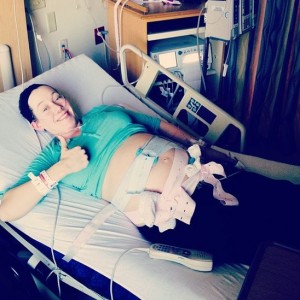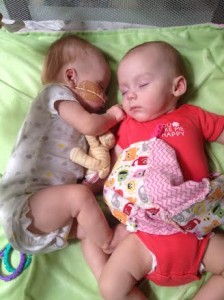This is an article I wrote for Twiniversity.com. Our girls were lucky enough to be featured as their "Twines of the Month" on their blog when they were 6 months old. This is how our story starts:
The Pregnancy
My wife Jennifer and I found out we were pregnant about 5 weeks after our 7th wedding anniversary. We were so excited to see the positive pregnancy test that we immediately went into baby mode, trying to imagine what sex it was going to be, what the baby would be like, what would life be like after almost 10 years of just being us? It was so hard to picture a third member of our family, but it was the best news we had ever received. When we went in for the 8 week ultrasound appointment, we almost held our breath as the tech began looking around for our baby’s heartbeat. “Well, you’re definitely pregnant,” she said. “ But there’s not one, but TWO heartbeats!” A short pause. “Wait…no…are you ready? There’s another one. Yep, there it is. You are pregnant with triplets.” All that we could do was laugh. We looked at each other with blank, indefinable expressions as we digested what the woman had just told us. She looked at us and grinned, obviously enjoying the dumbfounded looks on our face and our inability to form words or sentences. She must have announced it to every member of the staff, because as we walked out of the office, they were all whispering and smiling at us as if we had just won the lottery.
 Because we were now expecting triplets, it was considered a “high risk pregnancy,” and the OB/GYN that we were seeing had to refer us to a group of specialty perinatal doctors here in town. They took over and found that Babies A and B were Monoamniotic-Monochorionic, often referred to as Mono-Mono, or MoMo twins. What that means is that they share not only an amniotic sac, but also the same placenta. This putthem at a much higher risk, since it is incredibly easy for their two umbilical cords to become tangled, knotted, and cut off circulation to one or both babies. The doctor informed us that this type of pregnancy almost always required an extensive, hospitalized bed rest for the mother, for continuous monitoring and to decrease the risk of an entanglement. We also found out that while Baby C had its own sac and placenta, it was almost completely covered by a condition called Hydrops Fetalis, which is massive fluid buildup in the tissues of the fetus. Baby C did not make it past 12 weeks.
Because we were now expecting triplets, it was considered a “high risk pregnancy,” and the OB/GYN that we were seeing had to refer us to a group of specialty perinatal doctors here in town. They took over and found that Babies A and B were Monoamniotic-Monochorionic, often referred to as Mono-Mono, or MoMo twins. What that means is that they share not only an amniotic sac, but also the same placenta. This putthem at a much higher risk, since it is incredibly easy for their two umbilical cords to become tangled, knotted, and cut off circulation to one or both babies. The doctor informed us that this type of pregnancy almost always required an extensive, hospitalized bed rest for the mother, for continuous monitoring and to decrease the risk of an entanglement. We also found out that while Baby C had its own sac and placenta, it was almost completely covered by a condition called Hydrops Fetalis, which is massive fluid buildup in the tissues of the fetus. Baby C did not make it past 12 weeks.
So there we are, in the last 4 weeks or so, we went from finding out that we were pregnant with triplets, then finding out it was a severely high risk pregnancy, then losing one of the babies. This pregnancy was already proving to be quite the roller coaster.
 Then, at 20 weeks, we were hit again when another ultrasound tech saw something that didn’t look quite right on Twin B, now named Zoë’s heart. Zoë had a rare but severe heart defect called Transposition of the Great Arteries. This means that the position of the two major arteries of her heart, the Pulmonary Artery and the Aorta, were switched, and blood did not flow through her body the way it was supposed to. Zoë’s heart pumped oxygen rich blood back to the lungs instead of out to the body, and oxygen poor blood never made it to the lungs before being pumped back to the body. Zoë would need a major open heart surgery after birth to cut each artery, redirect them to pump in the correct directions, and sew them back together. At the same appointment, a doctor we hadn’t seen before spilled the news that we were having girls. This was bittersweet, since we had planned on waiting until birth to find out the sex.
Then, at 20 weeks, we were hit again when another ultrasound tech saw something that didn’t look quite right on Twin B, now named Zoë’s heart. Zoë had a rare but severe heart defect called Transposition of the Great Arteries. This means that the position of the two major arteries of her heart, the Pulmonary Artery and the Aorta, were switched, and blood did not flow through her body the way it was supposed to. Zoë’s heart pumped oxygen rich blood back to the lungs instead of out to the body, and oxygen poor blood never made it to the lungs before being pumped back to the body. Zoë would need a major open heart surgery after birth to cut each artery, redirect them to pump in the correct directions, and sew them back together. At the same appointment, a doctor we hadn’t seen before spilled the news that we were having girls. This was bittersweet, since we had planned on waiting until birth to find out the sex.
At 26 weeks into the pregnancy, Jennifer checked into the hospital, where she would remain on continuous fetal monitoring day and night, until our babies were born. I worked during the day, went home to feed our dog and cats, then drive to the hospital to spend the night with my wife. Every day.
The goal was to make it to 34 weeks, which was typical for Mono-Mono pregnancies, hoping the babies didn’t have any heart decelerations that would indicate a pinch in the umbilical cord. We went ahead and scheduled the C-section for June 20th. The girls, however, decided they were ready to meet us at 33 ½ weeks.
 The Birth
The Birth
Jennifer called me at work at 7:30 a.m. on January 16th, told me that her water had broke, and it was go time! I rushed downtown to the hospital and made it just as they were getting ready to wheel her to the OR. As they whisked her into the cold birthing room, I threw on a gown and received instructions on what to do. They brought me in and I sat by my wife’s head. I couldn’t help but peek over the curtain and watch as the surgeon pulled two of the most beautiful babies I have ever seen from the womb of the most beautiful woman I have ever known. Then, in a flash, the babies were whisked off to two separate incubators. Parker would stay here, in the NICU at Good Samaritan, while Zoë would be transferred to Phoenix Children’s Hospital a few miles away. Phoenix Children’s was the only hospital nearby that had a cardiac specific NICU, or CVICU.
Two Sisters, Two Hospitals
Parker was quite healthy when she was born. She weighed 5 lbs, 9 oz. She would have to stay at Good Samaritan until she gained some weight and learned how to eat from a bottle. This proved to be no easy task for a preemie twin, and she stayed in the NICU for about a month and a half while Jen and I bounced back and forth between home and the two hospitals to see each of our daughters. Zoë was 4 lbs 15 oz when she was born, was intubated with a breathing tube right away, given a central IV line, and had to wait until she gained a couple more pounds before she would have her heart surgery.
 We would typically spend the first half of the day with Zoë at Phoenix Children’s to hear the doctors’ rounds and get updates, then go to Good Samaritan to spend the rest of the day with Parker, until we had to go home for the night. This went on for about 5 weeks or so, until Parker came home with us. The hospital wouldn’t let children who weren’t patients onto the hospital floor due to flu precautions, so we were lucky that our families lived close by to help watch Parker while we would visit Zoë.
We would typically spend the first half of the day with Zoë at Phoenix Children’s to hear the doctors’ rounds and get updates, then go to Good Samaritan to spend the rest of the day with Parker, until we had to go home for the night. This went on for about 5 weeks or so, until Parker came home with us. The hospital wouldn’t let children who weren’t patients onto the hospital floor due to flu precautions, so we were lucky that our families lived close by to help watch Parker while we would visit Zoë.
Zoë had a balloon septostomy procedure done to open a temporary hole in the wall of her heart so that oxygenated blood could mix with the de-oxygenated blood, and be carried to her body. This would allow her to make it until the real surgery, but a bout of NEC, or Necrotizing Enterocolitis ended up pushing the operation back even further. Zoë had her heart surgery on February 19th. Our doc was touted as one of the best in the country, and one of the only ones in the state who could pull a procedure like this off. He lived up to his reputation, and the surgery was a success.

Still reliant on a breathing tube, with drains, IVs, monitors and central lines, we weren’t able to hold our daughter for weeks. Actually, we had only held her a few times before the surgery, and now it was almost unbearable. Seeing our daughter in so much pain and not being able to console her was the most difficult thing we have ever done. The most contact we had was laying our hands on her head or the parts of her that weren’t bandaged or a mess of wires and tubes. After the surgery, she suffered from a collapsed lung, requiring another surgery to repair it, and then two failed extubations (removal of the breathing tube) before she was finally able to breathe on her own. Seeing that tube come out was such a glorious moment, because it meant one step closer to having our baby girl at home with us.
I can’t really say how Zoë felt throughout all of this, but I do know that she seemed to always know when Jen and I were there with her. She seemed more calm and at ease when we were standing there beside her hospital crib, singing to her, playing her music, and telling her how much we loved her and couldn’t wait until she came home.
Flu restrictions lifted at the hospital, and we finally got permission to bring Parker in with us to see her sister for the first time since in the womb. We put Parker in the crib Zoë was in, and Parker instantly reached over to grab Zoë’s arm, though Zoë didn’t seem to know what to make of her sister at first.
 Home At Last
Home At Last
Zoë finally came home with us almost 3 months after she was born, on April 10th. This was the happiest moment we had since finding out we were pregnant.
She still didn’t know how to eat by bottle, so she was sent home with us with an NG tube by which she received all of her nutrition and a slew of medications, which we are weaning off even now. She still has the NG tube, but she has been learning how to eat at an incredible pace. We have been making multiple weekly doctors visits, speech therapy for feeding, physical therapy, and she will have regular cardiologist visits for the majority of her life.
To see her now, nearing 6 months old, it is hard to believe she is the same frail little baby she was a few months ago. She is now healthy, happy, and home. When she lays with her sister they hold hands and snuggle, as if they don’t want to be apart (until nap time, then it can get ugly). She giggles and coos and makes all of the amazing faces we were never sure we would see. She’s even in swim lessons and loving it. As a family we have already been through more than most, and it has brought us closer to each other than we thought possible. Without each other, we never would have made it through any of it.